Holi story (Kaam dahan / Holika dahan, burn) information, facts, importance, significance
Namaste friends, how are you doing today? Welcome to #BhagavanBhakthi website / blog.
Bhagavan Lord Sri Vishnu (Krishna) (Rama) blessings to you and your family!
In this website / blog, you will always learn about #Hinduism #Sanskrit language.
Also subscribe to my YouTube channel from this link #BhagavanBhakthi to view videos about #Hinduism #Sanskrit language.
Just before going to “Holi story (Kaam dahan / Holika dahan, burn) information, facts, importance, significance“, let us have some brief information.
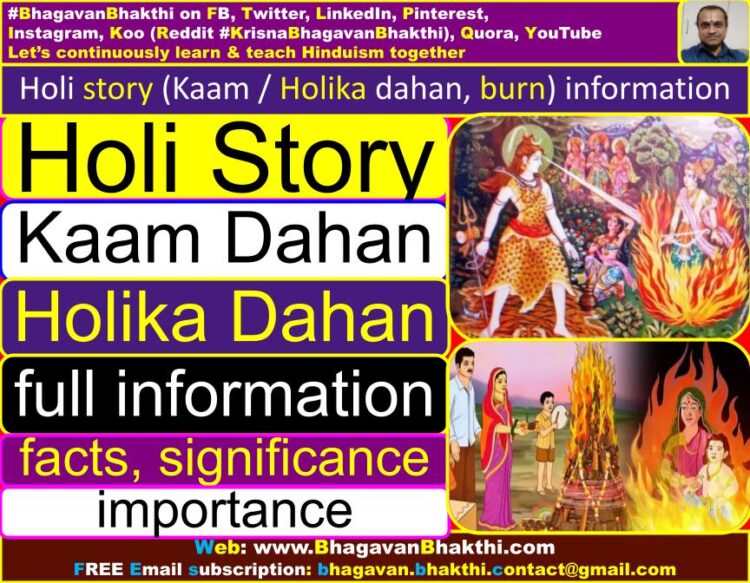
First let us understand, what is the meaning of Holi? Holi represents the Festival of colors.
It is celebrated on the purnima (full moon day), that is, in phalguna masam (month) every year. It is popularly called as “Kaama dahana/ Kaam dahan”.
(“Kaama dahana / काम दहन / kāma dahana” are Sanskrit words. In Hindi it is written as Kaam dahan.)
It is the day on which Mano niyamaka (controller of mind) Lord Shiva burnt Lord Sri Kama Deva with his third eye.
Now, let us know that correct story according to our Puranas:
Kaam Dahan story is as given below:
Once ‘The Kailash-vasi Mano Niyamaka Deva’, that is, Lord Shiva was in deep tapas, had lost all his interest in the love and thus all material likings had stopped in him.
[Here Kailash Vasi Mano Niyamaka Deva means, he (Lord Shiva) is the one who stays in Kailash and he is the one who controls everyone’s mind.]
All the Devatas (Demigods) in anxiety approached Lord Sri Kama Deva (deity of love), who fired an arrow of love at Lord Shiva.
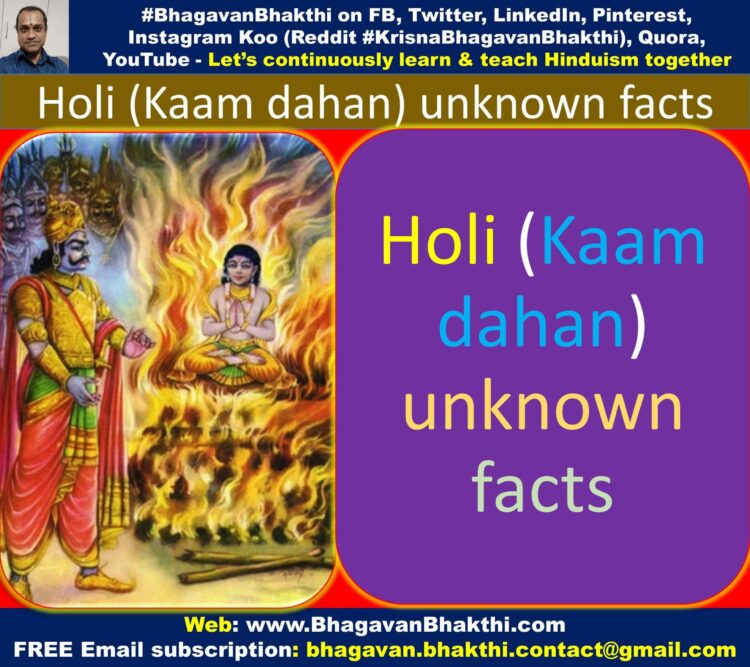
Thus Lord Shiva tapas was disturbed and he opened his third eye which is present on his forehead and burnt down Lord Sri Kama Deva into ashes immediately.
Goddess Sri Rati Devi, Lord Sri Kaama Deva’s wife performed severe penance henceforth.
Lord Shiva promised Goddess Sri Rati Devi that Lord Sri Kama Deva would return to her and resume the spread of love and procreation soon, but after some time.
Lord Shiva also said that, Lord Sri Kama Deva will however be formless or “Ananga” to all, expect her (Goddess Sri Rati Devi).
(Here Ananga means, someone who is present, but not visible, that is, who doesn’t has the physical body.)
Story of Holika (Holika Dahan) is as given below:
Holi festival is associated with the death of an ‘asuri’ (Demoness) named Holika (the sister of Hiranyakashipu or Hiranyakashyap and Hiranyaksha).
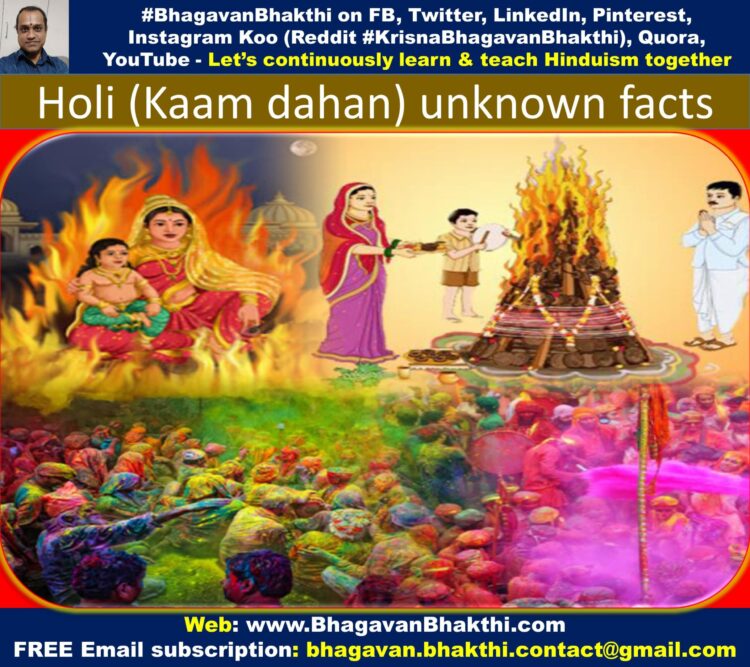
The King of the demons Hiranyakashipu (Hiranyakashyap), with the support of the boons granted by Lord Sri Brahma Deva had become very powerful and wanted to be worshipped as Bhagavan (God) by one and all.
Thus Hiranyakashipu (Hiranyakashyap) ordered all his people that “Hiranyakashipu is the Sarvottama / Supreme Bhagavan (God), and no one else should be worshipped hence forth in his kingdom”.
All the people had to tell “Sri Hiranyakashyapaya namaha” instead of “Sri Narayanaya namaha“.
But, his Great son Prahlada, a staunch bhakta / devotee of Lord Sri Vishnu refused to accept his father’s supremacy.
Hiranyakashipu, could not tolerate that his own son Prahlada is not accepting his sarvottamatva / supremacy. So Hiranyakashipu decided to kill Prahlada.
After trying several attempts to kill Prahalada in vain, Hiranyakashipu sent his sister, Holika who possessed the boon of never being burnt by agni / fire.
Young Prahlada was made to sit on his aunt’s (Holika) lap. A bonfire was lit with Prahlada and Holika at the center.
To the disappointment of Hiranyakashipu, Holika was burnt to ashes, while surprisingly to Hiranyakashipu, that Prahlada was spared by the agni / fire, by the grace of Lord Sri Vishnu.
The bonfire lit and the burning of the effigy of Holika during Holi, symbolizes the triumph of goodness over evil, humility over haughtiness and power of bhakti (devotion) over mere physical strength.
(Here we should note that the simile is blessed not to be burnt even if she enters the fire only if she is doing dharmakarya / dharma work.)
(From here, she was doing unrighteousness and she was doing the opposite of blessing, she got caught up in her own problems and thus burned in the fire.)
[This is the right meaning of ‘dharmo rakshati rakshitah’, that is, Dharma will save us if we are in the Dharma (right) path and Dharma won’t save us, if we are in the Adharma (incorrect) path.]
Lord Sri Kama Deva was born as son of Lord Sri Krishna & burnt a demon named Vakrasura:
Once Lord Sri Krishna did the penance to Lord Shiva for getting a child.
(This is only for loka shikshanaartha, that is, to teach the worldly people about how to do penance of Lord Shiva.}
(We should note that Lord Shiva and Goddess Sri Parvati Devi were blessed with the anugraha / blessings of Daampatya / wedlock by svayam Lord Sri Maha Vishnu.)
(If one worships these Great dampati / couple, they will get good daampatya for whole of their life. As such, to teach the people, Lord Sri Krishna did the penance to Lord Shiva).
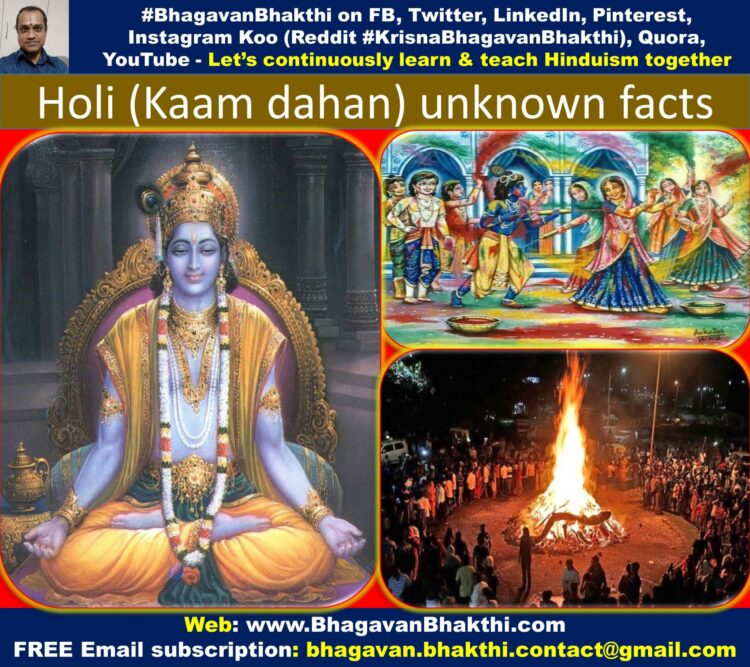
During his (Lord Sri Krishna’s) penance, Vakrasura named asura (demon) tried to disturb Lord Sri Krishna.
Lord Sri Krishna immediately did the srushti (creation) of Lord Sri Kama Deva / Manmatha, who killed that asura (demon) Vakrasura. Then later Manmatha went back.
This shows that Lord Sri Krishna need not have done the tapas to Lord Shiva. But, it is only for loka shikshanaartha, that is, to teach the worldly people on how we should do tapas to Lord Shiva, thus for this reason tapas was done by Lord Bhagavan Sri Krishna.
Subsequently Lord Sri Krishna again got Lord Sri Kama Deva (Manmatha) (that is Pradyumna) through Goddess Sri Rukmini Devi during the Mahabharata period.
Thus, Lord Sri Kaama Deva (Manmatha) was again born as the son of Lord Sri Krishna.
Further, one must note that Lord Sri Kama Deva (Manmatha) who was burnt alive by Lord Shiva was was during his direct roopa (form) as Lord Sri Kama Deva (Manmatha).
While, some stories have been misinterpreted wherein they have told that Lord Sri Krishna’s son Manmatha (that is Pradyumna) was burnt by Lord Shiva. Hence this clarification is given.
On the great occasion of Holi, huge bonfires are lit with logs of wood, dried cow dung round shaped cakes, ghee, honey and the new crops brought from the fields.
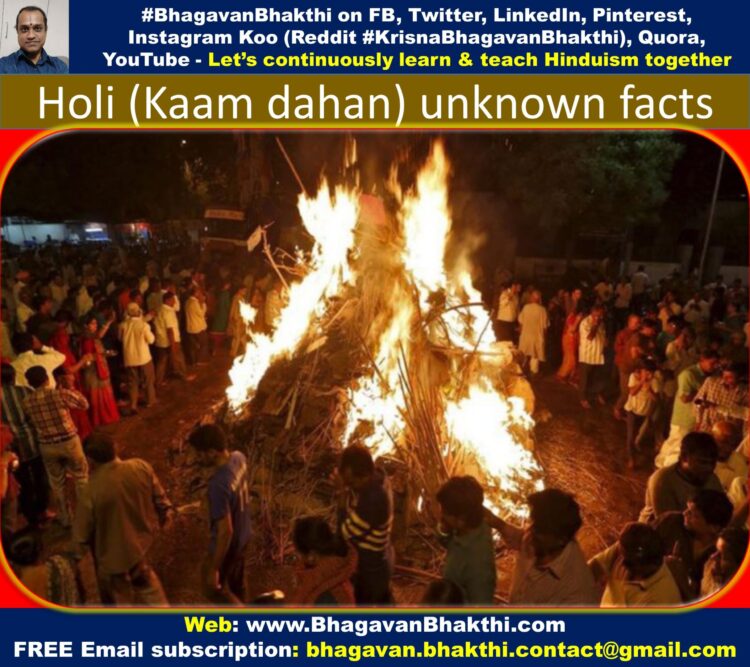
Women prepare delicious foods, sweets etc and put it in the bonfire as “Naivedya” (offering) to the “Sri Agni Deva” the celestial deity, that is Fire God.
The ash from the extinguished fire is applied on the forehead by all.
The ash is preserved at home all through the year and used as an effective remedy against impending evil effects.
For farmers, Holi means joyful celebration of the new harvest, bubbling with joy and excitement. At the yield of prosperity, they offer their first crop to the Sri Agni Deva, who is looked upon with love and esteem.
Only after this the crop is used for personal consumption by others. In ancient days, Holi was celebrated as “Vasantotsava” acclaiming it as a spring festival.
Why we apply colors on the day of Holi:
The legend from which the tradition of playing colors is as follows. The story or legend is based on Radha Rani Krishna Story.
Once Lord Sri Krishna who saw Radha Rani to be more fair than himself (Lord Sri Krishna) got jealousness on her beauty.
As Lord Sri Krishna was dark and Radha Rani had beautiful sveta ranga (fair color), Bhagavan Sri Krishna complained this to his maata / mother Sri Yashoda Devi.
To please her son (Bhagavan Sri Krishna), Sri Yashoda Devi told Lord Sri Krishna to apply some color on the face of Radha Rani, which would change the complexion of his (Lord Sri Krishna’s) choice.
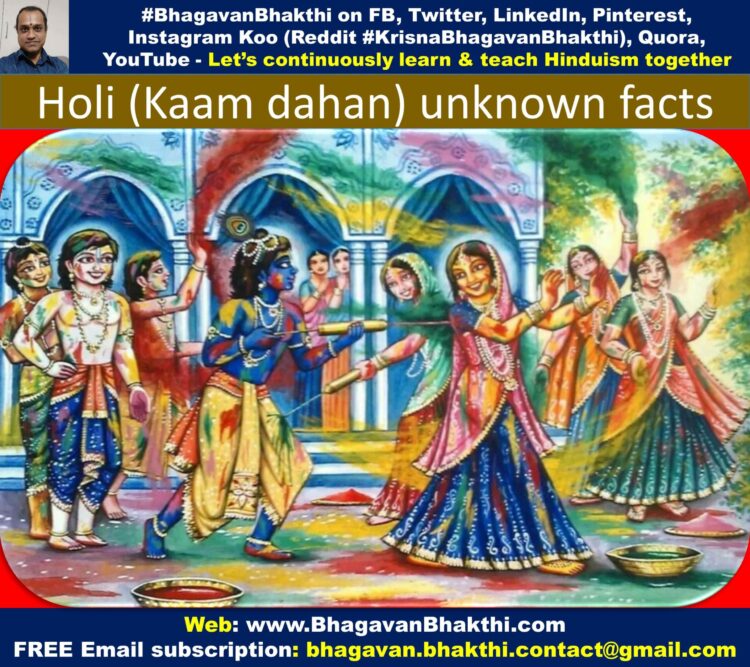
For this the Great mischievous balaka (child) Bhagavan Sri Krishna was happy with the idea and implemented it by applying various colors on the face of Radha Rani.
From that day, it became a paramapara / tradition and it turned out to be so popular that it became a Great festival of colors, which is being spread over all the parts of the world (Now it is limited to India).
Another story of Holi from Krita Yuga (Satya Yuga)
In Krita Yuga (Satya Yuga), Maharaja Raghu (vamsha / Vansh / family of Lord Sri Rama Chandra Prabhu) was in ruling the world.
One rakshasi (female demoness) named Dunda, used to disturb the peace of the children in the city of Maharaja Raghu.
The people of the city pleaded before Maharaja Raghu, who himself went to Narada Maharshi for help and guidance.
Narada Maharshi told him that rakshasi has boon and she can be killed by mischievous boys.
Narada Maharshi guided that on Phalguna poornima, the boys shall wonder throughout the city, boys shall collect wood, and other burnable items from various streets.
The huge collection shall be grouped with “Rakshogna” mantra. They shall do 3 pradakshina (circling) to the Sri Agni Deva (Fire God).
Narada Maharshi continued, they shall scold with avaachya words, then she will go out.
That is why it is in practice that the people will collect wood from different streets, from different homes and light all those collected by those young boys.
Kaama dahana (Kaam dahan)
For our saadhana, there will be many obstacles. We should pray to Mano Niyamaka Lord Shiva to destroy all our ‘Dush Kaamas’ (bad desires), and pray to Mano Niyamaka Lord Shiva to guide us in the right path of the Sanatana Dharma as per the teachings of Lord Sri Krishna.
It is in practice that on this day, special dishes are cooked as per the rituals of the house and dishes are kept as naivedya (bhog) to Lord Sri Vishnu and later is consumed by everybody.
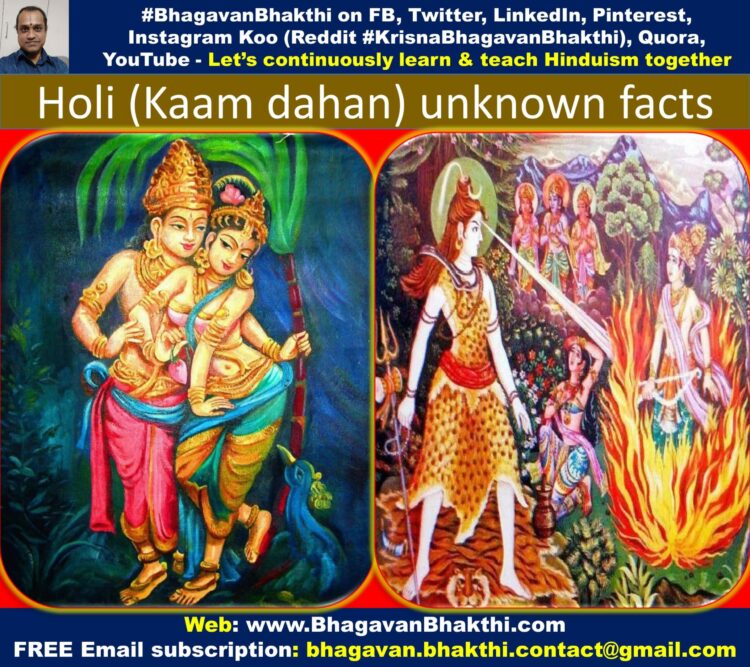
More information will be added to this on regular basis, please visit after some time to know more information.
To watch videos on #Hinduism #Sanskrit language, SUBSCRIBE to my YouTube channel from this below link:
#BhagavanBhakthi YouTube channel
Continue reading to know about “Lord Sri Vishnu information (facts) (details)” from here:
Lord Sri Vishnu information (facts) (details)
Continue reading to know about “Lord Shiva (full) information (facts) (details) – Part 2 of 2” from this below link:
Lord Shiva (full) information (facts) (details) – Part 2 of 2
To watch about “Lord Sri Krishna information” YouTube video, click the below YouTube video link:
Lord Sri Krishna information (YouTube videos)
To read about “Lord Sri Krishna information (website / blog reading)“, please click the below link:
Lord Sri Krishna information (website / blog reading)
Dear friends, if you need any clarifications about this post, kindly let me know, I will definitely try to answer all of them.
Also your one LIKE, one COMMENT, One Share, one SUBSCRIPTION is highly important.
This will help to know the quality of this content and also it will be helpful to know if any improvements is required for the content.
If you feel this content is useful to you and has helped you to improve your knowledge, kindly share this with your well-wishers.
Because “SHARING MEANS CARING”.
To receive FREE EMAIL SUBSCRIPTION about #BhagavanBhakthi, you can send an email to [email protected] from your email ID.
NAMASTE!
Sri Gurubhyo Namaha
Sri Krishnaaya Namaha
Sri Krishnaarpanamastu
Share in Social Media